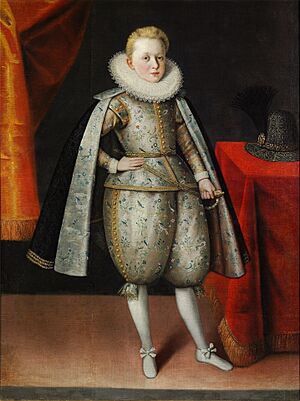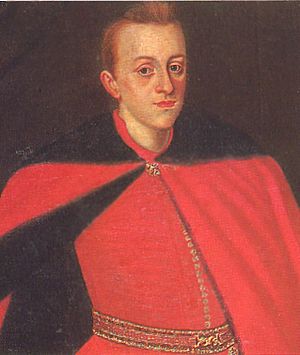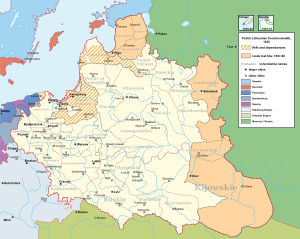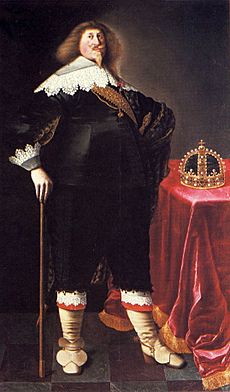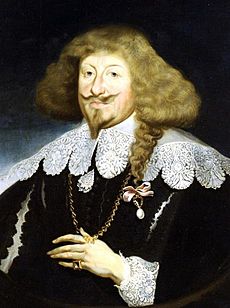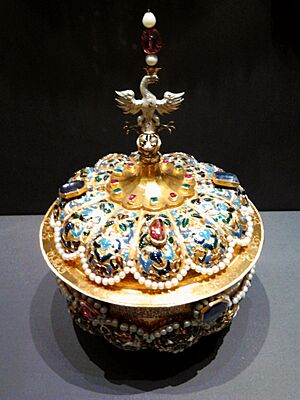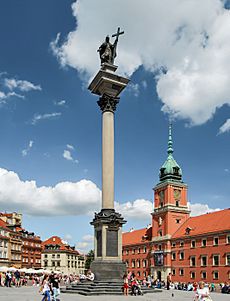Władysław IV Vasa facts for kids
Quick facts for kids Władysław IV Vasa |
|
|---|---|
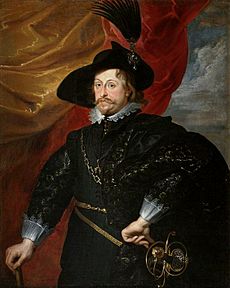
Portrait by Peter Paul Rubens
|
|
| King of Poland Grand Duke of Lithuania |
|
| Reign | 8 November 1632 – 20 May 1648 |
| Coronation | 6 February 1633 |
| Predecessor | Sigismund III Vasa |
| Successor | John II Casimir Vasa |
| Tsar of Russia (disputed) | |
| Reign | 19 July 1610 – 21 February 1613 |
| Predecessor | Vasili IV |
| Successor | Michael I |
| Born | 9 June 1595 Łobzów, Polish–Lithuanian Commonwealth |
| Died | 20 May 1648 (aged 52) Merkinė, Polish–Lithuanian Commonwealth |
| Burial | Wawel Cathedral, Kraków |
| Spouse | Cecilia Renata of Austria Marie Louise Gonzaga |
| Issue more... |
Sigismund Casimir Maria Anna Isabella Władysław Konstanty (illegitimate) |
| House | Vasa |
| Father | Sigismund III of Poland |
| Mother | Anne of Austria |
| Religion | Roman Catholic |
| Signature | |
Władysław IV Vasa (born June 9, 1595 – died May 20, 1648) was the King of Poland and Grand Duke of Lithuania. He also claimed the thrones of Sweden and Russia. Władysław was born into the House of Vasa family. He was the oldest son of Sigismund III Vasa and his first wife, Anna of Austria.
In 1610, Władysław was chosen to be the Tsar of Russia by a group of Russian nobles. This happened when the Polish army captured Moscow. However, he never actually became tsar because of his father's wishes and a local uprising. Even so, he used the title of Grand Duke of Muscovy until 1634.
Władysław was elected King of Poland in 1632. He was very good at defending the Polish–Lithuanian Commonwealth from invaders. A famous example is the Smolensk War (1632–1634), where he fought personally. He believed in religious tolerance and made important changes to the army. He even started a navy for the Commonwealth.
Władysław was also a big supporter of arts and music. He became famous for defeating the Ottoman Empire. He tried to make the king's power stronger and improve Poland's government. Although he didn't get back the Swedish throne, his friendly personality made him popular. This helped keep peace inside the Commonwealth.
He died without a son who could legally take his place. His half-brother, John II Casimir Vasa, became the next king. Władysław's death led to a time of trouble for Poland. Big conflicts like the Khmelnytsky Uprising and the Swedish invasion (called "the Deluge") weakened the country. Because of this, Władysław's time as king was later remembered as a peaceful and successful "golden era."
A King's Journey
Early Life and Family
Władysław IV's father, Sigismund III Vasa, was the grandson of King Gustav I of Sweden. Sigismund became King of Sweden in 1592. But his uncle, who later became King Charles IX, removed him from the throne in 1599. This started a long fight, with Polish kings from the Vasa family claiming the Swedish throne. This led to wars between Poland and Sweden for many years.
Władysław was born on June 9, 1595. His mother, Anne of Austria, died when he was less than three years old. He was raised by one of her ladies-in-waiting, Urszula Meierin. She became very important at the royal court.
As Władysław grew up, he had new teachers and mentors. He studied at the Kraków Academy and also spent two years in Rome. He learned to speak and write in German, Italian, and Latin. He was very interested in the arts, which later made him a great supporter of artists.
A Claim to the Russian Throne
When Władysław was 15, in 1609, his family moved to Vilnius. This was the capital of the Grand Duchy of Lithuania. He saw a big fire there that made the royal family leave Vilnius Castle. Later that year, Russian nobles chose Władysław to be their Tsar. This happened during a time of trouble in Russia, when the Polish army had captured Moscow.
However, Władysław's father, Sigismund, stopped him from becoming tsar. Sigismund wanted to change the Russian people from their Orthodox religion to Catholicism. He refused to let Władysław go to Moscow and become Orthodox. Instead, Sigismund wanted to rule Russia himself. This plan didn't work, and fighting started again.
Władysław tried to win the Russian throne himself in 1616. He won some battles but couldn't capture Moscow. Poland gained some land in a peace deal, but Władysław never ruled Russia. The throne went to Michael Romanov. Władysław kept the title of tsar until 1634, but he had no real power. This experience showed Władysław how limited the king's power was in Poland. The Polish parliament, called the Sejm, often refused to pay for wars.
A Prince's Military Adventures
Before he became king of Poland, Władysław fought in many battles. In 1620, he joined the Polish–Ottoman War (1620–1621). In 1621, he was a Polish commander at the Battle of Chocim. Even though he was sick, he convinced other commanders to keep fighting. His advice was right, and the battle ended in a peace treaty. This made Władysław famous as a "defender of the Christian faith." It also made him very popular in Poland.
In 1624, Władysław traveled to Western Europe. He visited many cities and met important people. In Antwerp, he met the famous painter Peter Paul Rubens. In Italy, he met Pope Urban VIII, who praised him for fighting the Ottomans. In Florence, he was amazed by opera. He decided to bring this new art form to Poland, where it was unknown before. He also saw shipyards in Genoa and Venice. These experiences made him want to create a Polish–Lithuanian Commonwealth Navy.
After returning to Poland, he fought against the Swedes in the Polish–Swedish War (1626–1629). This war ended with a peace agreement in 1629. During this time, Władysław tried to get support to become the next king of Poland. His father, Sigismund, was getting old, and Polish kings were chosen by election, not by birth. The Polish nobility, called the szlachta, didn't like the idea of choosing a king while the old one was still alive. So, Władysław's efforts failed for a while.
However, his father Sigismund died suddenly in April 1632. This meant a new king had to be chosen.
Becoming King of Poland
The election for the new king happened in 1632. Władysław was the clear choice. He was officially announced as king on November 13. Before becoming king, he had to agree to certain promises, called pacta conventa. He promised to fund a military school and a navy. He also promised not to declare war or make peace without the Sejm's approval. Władysław was crowned in Wawel Cathedral in Kraków on February 6, 1633.
Military Successes
Soon after Władysław became king, Tsar Michael I invaded Poland. A Russian army attacked the city of Smolensk in October 1632. In the Smolensk War (1632–1634), Władysław led his army to break the siege in September 1633. He then surrounded the Russian army, forcing them to surrender in March 1634.
During this war, Władysław modernized the Polish army. He focused on new infantry and artillery methods from Western Europe. He was a good military leader. The war ended with the Peace of Polyanov treaty. This treaty was good for Poland and confirmed its borders. Russia also paid money to Władysław in exchange for him giving up his claim to the Russian throne.
After the Smolensk campaign, the Ottoman Empire threatened Poland. In the wars against Ottomans (1633–1634), Władysław moved his army south. Under the command of Stanisław Koniecpolski, the Polish army forced the Ottomans to renew a peace treaty. This treaty confirmed Poland's independence and stopped border raids.
Next, Poland faced a threat from Sweden. The peace agreement from the previous war was ending. Most Polish nobles wanted to solve the problem peacefully. Władysław wanted to fight for more land, but the Sejm and Senate disagreed. So, both sides signed the Armistice of Stuhmsdorf in 1635. This treaty was good for Poland. It gave back Polish lands and reduced Swedish taxes on sea trade.
Royal Politics and Challenges
Władysław wanted to play a big role in European politics. He tried to help end the Thirty Years' War in Europe. He hoped this would help him get back the Swedish crown. But he soon realized that getting the Swedish throne was unlikely.
From 1636, Władysław tried to make the king's power stronger in Poland. He wanted to create a special area in the country that would belong to his family forever. But the Sejm didn't support this. He also tried to create a special award for knights, but the nobles saw this as a way for the king to create a loyal group of followers. They didn't want their own power to be reduced. All his plans to increase royal power failed. The Sejm even passed laws to limit his authority, showing how weak the king's position was in Poland.
Marriages and Heirs
Władysław married Cecilia Renata of Austria in 1637. She was the sister of the future Holy Roman Emperor. This marriage strengthened ties between Poland and the Habsburg family. They had a son, Sigismund Casimir.
After Cecilia died in 1644, Władysław's ties with the Habsburgs weakened. He then married Marie Louise Gonzaga from France in 1646.
Władysław's last big plan was to start a war between European powers and the Ottoman Empire. He hoped this war would also solve problems with the Cossacks, a group of warriors living near the Ottoman border. He wanted them to fight for Poland instead of against it. But, as usual, the Polish nobles in the Sejm didn't want to pay for another war. Władysław's health also got worse.
On August 9, 1647, his young son, Sigismund Casimir, died suddenly at age seven. This was a huge blow to the king, as his son was his only legal heir.
Death of the King
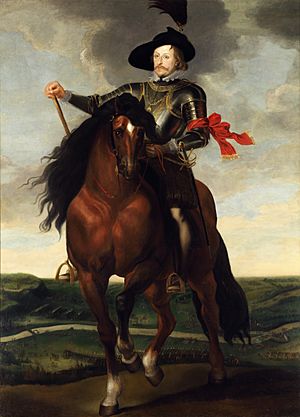
In early 1648, while hunting, Władysław became very ill with gallstones or kidney stones. His condition worsened, and he knew his end was near. Władysław died on May 20, 1648.
Since he had no legal sons, his half-brother, John II Casimir Vasa, became the next king.
A King of Culture
Personality and Spending
Władysław was known for being friendly and outgoing. He had a good sense of humor and could charm many people. However, he could also get angry quickly and act without thinking.
He was criticized for spending too much money. He lived a very fancy life, and his royal court spent more than it could afford. He also gave a lot of money to his courtiers, who some people thought were taking advantage of the king.
Patron of the Arts
One of Władysław's greatest achievements was his support for the arts. He loved theater and music. He spoke several languages and enjoyed reading history and poetry. He collected many paintings and created a famous art gallery in the Warsaw castle. He had a large collection of Italian and Flemish Baroque paintings, though many were lost in later wars.
Władysław supported many musicians. In 1637, he built the first theater in a Polish palace. Dozens of operas and ballets were performed there during his reign. He is given credit for bringing opera to Poland. He was also interested in maps, history, and science. He even wrote letters to the famous scientist Galileo.
Some famous artists he supported were Peter Paul Rubens, Tommaso Dolabella, and Wilhelm Hondius. His royal orchestra was led by Marco Scacchi.
One of the most famous things he ordered was the building of Sigismund's Column in Warsaw. This column was dedicated to his father, Sigismund III.
What Władysław Achieved
Władysław had many big plans, like gaining more land or getting back the Swedish throne. Most of these plans didn't work out during his 16-year reign. However, he did improve Poland's foreign policy. He helped set up a network of permanent diplomats in important European countries.
Throughout his time as king, Władysław successfully defended Poland from foreign attacks. He was seen as a good military leader who did a lot to modernize the Polish Army. He made sure there were enough officers so the army could grow. He also brought in new Western infantry tactics and supported the growth of artillery. His attempt to create a Polish–Lithuanian Commonwealth Navy led to a new port village called Władysławowo. But he couldn't get enough money for the navy, and the ships were gone by the 1640s.
Even though he was Catholic, Władysław was very tolerant of other religions. He didn't support harsh policies against Protestants. When he became king, the Polish Senate had 6 Protestant members. By the time he died, it had 11. However, he couldn't stop the growing intolerance in Poland or solve the conflict with the Orthodox Cossacks.
In Poland's internal politics, he tried to make the monarchy stronger. But the szlachta (nobility) valued their independence and democratic powers. They often stopped the king's plans. Władysław was frustrated with the king's weak position in the Commonwealth. He wanted to secure a small, hereditary territory where his power would be much greater.
Władysław used the title of King of Sweden, even though he never ruled Sweden. He kept trying to get the Swedish throne, but like his father, he failed.
Some historians see Władysław as a dreamer who couldn't stick to one plan. When he faced problems, he would often give up and look for something new. Perhaps this is why he couldn't inspire people to fully support his plans. However, other historians point out that his reign was short and the king's power was already weak.
Years after his death, Russia demanded that books about Władysław's victories in the Smolensk War be collected and burned. This demand was met, which was seen as a shameful event by many Poles.
Royal Titles
Władysław's full title in Latin was: "Vladislaus Quartus Dei gratia rex Poloniae, magnus dux Lithuaniae, Russiae, Prussiae, Masoviae, Samogitiae, Livoniaeque, Smolenscie, Severiae, Czernichoviaeque necnon Suecorum, Gothorum Vandalorumque haereditarius rex, electus magnus dux Moschoviae."
In English, this means: "Władysław IV, by grace of God the King of Poland, Grand Duke of Lithuania, Ruthenia, Prussia, Masovia, Samogitia, Livonia, Smolensk, Severia and Chernigov and hereditary King of the Swedes, Goths and Vandals, elected Grand Duke of Muscovy."
Władysław's titles were the longest of any Polish king.
See also
 In Spanish: Vladislao IV de Polonia para niños
In Spanish: Vladislao IV de Polonia para niños
- History of Poland (1569–1795)
- Golden Liberty


